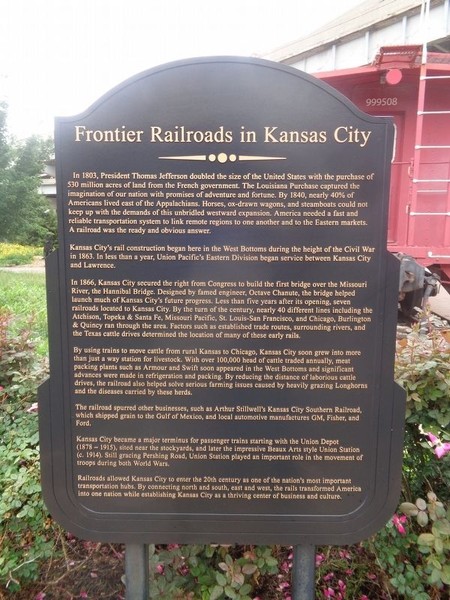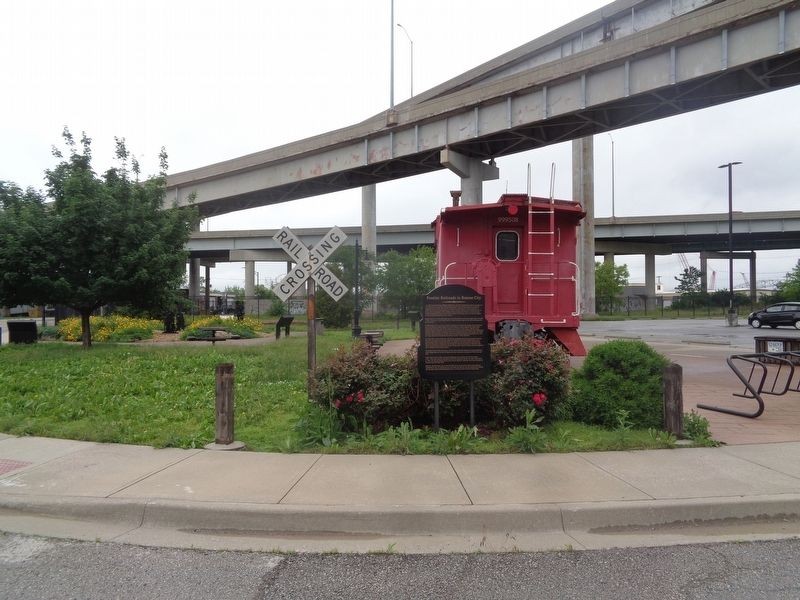Frontier Railroads in Kansas City Historical Marker
Introduction
Text-to-speech Audio
This historical marker in Kansas City's West Bottoms district shares the history of the first railroads that transported goods and people through Kansas City in the 1860s and 1870s, culminating with the construction of Union Depot which operated from 1878 to 1915 and its replacement, Union Station. In 1863, Lawrence and Kansas City were connected by a new line operated by the Union Pacific. After the Civil War, this part of Kansas City was selected for the first railroad bridge to cross the Missouri River. Within just five years of the completion of the Hannibal Bridge, there were five railroad companies operating in the West Bottoms including the Atchison, Topeka & Santa Fe, Missouri Pacific, St. Louis-San Francisco, and Chicago, Burlington & Quincy. These railroads led to the rapid development of the West Bottoms area and connected Kansas City to markets across the country. As a result, Kansas City was able to "grow into more than just a way station for livestock" - it became a hub of transport for live cattle, meat, and other agricultural products by way of the railroads.
Images
Frontier Railroads in Kansas City Marker

Frontier Railroads in Kansas City Marker

Backstory and Context
Text-to-speech Audio
Nationally linked steam-powered railroads didn't reach Kansas City until the 1860s, but their story started as far back as 1803 when President Thomas Jefferson bought the Louisiana Purchase from Napoleon's government. In doing so, Jefferson doubled the size of land claimed by the United States which encouraged western settlement and investment. By 1840, nearly forty percent of the people of European and African descent in lands claimed by the United States lived east of the Appalachians. With the settlement of western states like California, the United States had grown so large that travel, transport of goods, and even simply sending mail across the country was difficult and time-consuming. The answer to this problem was the railroad.
The first railroad connecting the West to the midwestern United States, fittingly called the First Transcontinental Railroad, was completed in 1869 after several years of work. The nearly two-thousand stretch of railway linked California to Iowa and, through it, the rest of the country. However, even though this railroad was such a massive undertaking, and even though there was an ongoing Civil War, it didn't bring railway construction elsewhere to a halt. In 1864, the Kansas Pacific Railway was completed, linking Kansas City to the rest of the state of Kansas, as well as Colorado. Over the next several decades, a series of other companies built their railroads through the city in all directions, connecting the city to others all across the country, from New Mexico and Texas to Illinois, Iowa, and Michigan.
In 1866, the Hannibal Bridge, the first railroad bridge to cross the Missouri River, was completed in Kansas City, directly connecting to the West Bottoms. This caused railroad and industry growth in the city to take off. Railroads belonging to companies such as the Atchison, Topeka & Santa Fe, Missouri Pacific, St. Louis-San Francisco, and Chicago, Burlington & Quincy were built through the area, and by the turn of the century, Kansas City was home to nearly forty different lines. The West Bottoms in particular became a center of transport for one of the city's biggest exports, cows, as well as other goods. The importance of the railroad to the city's growth is best put by the final paragraph on the marker:
Railroads allowed Kansas City to enter the 20th century as one of the nation's most important transportation hubs. By connecting north and south, east and west, the rails transformed America into one nation while establishing Kansas City as a thriving center of business and culture.
Sources
The Louisiana Purchase, Thomas Jefferson's Monticello. Accessed October 14th, 2022. https://www.monticello.org/thomas-jefferson/louisiana-lewis-clark/the-louisiana-purchase/.
The Beginnings of American Railroads and Mapping, Library of Congress. Accessed October 14th, 2022. https://www.loc.gov/collections/railroad-maps-1828-to-1900/articles-and-essays/history-of-railroads-and-maps/the-beginnings-of-american-railroads-and-mapping/#:~:text=The%20first%20railroad%20charter%20in,opened%20before%20the%20year%20ended..
Roberts, Eric. Rise of Monopolies - History of American Railroads, Stanford. Accessed October 14th, 2022. https://www.loc.gov/collections/railroad-maps-1828-to-1900/articles-and-essays/history-of-railroads-and-maps/the-beginnings-of-american-railroads-and-mapping/#:~:text=The%20first%20railroad%20charter%20in,opened%20before%20the%20year%20ended..
Sayej, Nadja. 'Forgotten by society' – how Chinese migrants built the transcontinental railroad, The Guardian. July 18th, 2019. Accessed October 14th, 2022. https://www.theguardian.com/artanddesign/2019/jul/18/forgotten-by-society-how-chinese-migrants-built-the-transcontinental-railroad.
HMDB - Jason Voigt
HMDB - Jason Voigt
